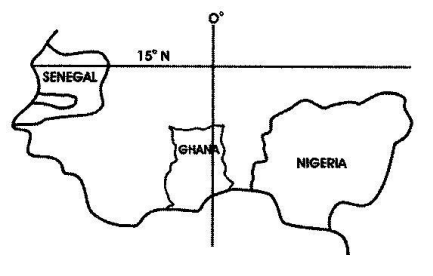1.
Our environment is made up of
plants and animals
roads and rivers
natural and man-made things
vegetation and climate
2.
Protection of the environment in Ghana must be the responsibility of
the government
the Environmental Protection Agency
all people within the community
the Forestry Department
3.
The first Ghanaian member of the legislative council was
James Kwegyir Aggrey
George Kuntu Blankson
John Sey
Nana Sir Ofori Atta I
4.
The main duty of the police in a community is to
arrest criminals
terrorize little children
direct traffic
settle disputes
5.
A model of the earth is called
a globe
an atlas
a map
a longitude
6.
Latitude normally marked zero on maps is called the
Capricorn
Cancer
Equator
Hemisphere
7.
Latitudes and longitudes are used to
decorate maps
locate object on maps
show the direction of streams flow
show heights of mountains on maps
8.
A teacher explained to his class that Kete Krachi is sited at the meeting place of two rivers. Kete Krachi can therefore be described as
group town
delta town
ridge settlement
riverine settlement
9.
An escarpment has
gentle slope on all sides
a round top and steep sides
a steep slope on one side and a gentle slope on the other
steep slope on all sides
10.
Latitude 66.5° South is also known as
Antarctic Circle
Arctic Circle
Greenwich Meridian
Prime Meridian
11.

Use the diagram above to answer the question below
The feature marked A in the diagram above is a
valley
spur
ridge
elbow
12.

Use the diagram above to answer the question below
The feature marked B in the diagram can best be described as a
spur
ridge
plateau
mountain
13.

Use the diagram above to answer the question below
The diagram represents a
mountain
ridge
plateau
plain
14.
The South-Western corner of Ghana has rains throughout the year because it is mostly influenced by the
North-East Trade Winds
Overhead Sun
Easterly Winds
South-West Monsoon
15.
Which of the following vegetation types cannot be found in Ghana?
Mangrove Forest
Temperate Woodland
Tropical Deciduous Forest
Guinea Savanna
16.
The Asante were in 1900, led to war against the British by
Osei Tutu
Osei Kwadwo
Kwasi Obodum
Nana Afriyie
17.
The people of Ghana were freed from Colonial rule on
28th February, 1948
6th March, 1957
1st July, 1961
4th June, 1979
18.
Kofi is a Member of Parliament, he therefore contributes to
administration of laws
arresting criminals
making of laws
judging criminals
19.
The main purpose of the Economic Community of West African States (ECOWAS) is to
achieve political freedom
achieve political unity
expand the size of West Africa
achieve economic integration
20.
The body that is working to prevent another world war is the
United Nations Organization (UNO)
League of Nations
Non-Aligned Movement (NAM)
Organization of African Unity (OAU)
21.
The leading producer of gold in West Africa is
Ghana
Nigeria
Liberia
Sierra Leone
22.
The Jos Plateau in Nigeria is noted for the production of
gold
bauxite
tin
diamond
23.
Which of the following prevents desertification?
Overgrazing
Shortage of water
Excessive use of fuel
Afforestation
24.
The first republic of Ghana covered the period
1957 to 1960
1960 to 1966
1966 to 1969
1969 to 1972
25.
The Education Act of 1961
reduced the school-going age
introduced the Junior Secondary School System
made Primary Education free and compulsory
made Basic Education universal
26.
The settlement often described as the industrial city of Ghana is
Accra
Kumasi
Tamale
Takoradi
27.
Cape Verde Island is found off the coast of
South Africa
West Africa
North Africa
East Africa
28.
The Poll tax ordinance failed because the
chiefs did not agree with the British to levy tax
people had no money to pay the tax
British used the money to support the Asantes against the Fantes
tax was too high for the people
29.
All the following are weekly newspapers in Ghana except the
Spectator
Ghanaian Times
Mirror
Voice
30.
The official seat of the government of Ghana is the
Flagstaff House
Peduase Lodge
Osu Castle
State House
31.
The Meteorological Services Department deals with
water
stars
power
minerals
32.
General Pardon for offences against the state is
amnesty
freedom
grant
libel
33.
Which of the following towns is well noted for Manganese mining?
Obuasi
Nyinahin
Tarkwa
Akwatia
34.
Laws for the country are made by
the President
Parliament
Supreme Court
District Assembly
35.
The liquid rock beneath the earth‟s surface is called the
mantle
crust
magma
layer
36.
On the maps, the sea is normally shown with the colour
green
yellow
white
blue
37.
The Organization of African Unity (OAU) is made up of only
Independent African States
Dependent African States
Colonial African States
Warring African States
38.
The Danes defeated the Anlos in the
Sagbadre war
Srogbo war
Sagrenti war
Dodowa war
39.
The festival of harvest of the people of Navrongo is known as the
Ohum festival
Foo festival
Odehuro festival
Ahwie festival
40.
The Mediterranean lands are well known for the production of
minerals
textiles
citrus
metals

a)
On the outline map of West Africa provided, insert the following features:
i)
Accra
ii)
Lagos
iii)
River Senegal
iv)
River Volta
v)
River Niger
vi)
Jos Plateau
b)
Mention any two reasons why most rivers in West Africa are not navigable.
a)
How are the following features shown on topographical maps?
i)
Railway
ii)
Marshy area
iii)
Court House
iv)
Mosque
v)
Market
vi)
Farm
b)
Mention two elements of the weather and the instrument used to measure each of them.
Explain any five achievements of Sir Alan Burns in the Gold Coast.
a)
Mention five types of timber found in the forests of Ghana.
b)
Give five reasons that make the timber industry important in Ghana.
Explain five reasons why the Moroccans defeated the Songhai Empire at the battle of Tondibi.
Describe five achievements of the Organization of African Unity (OAU)